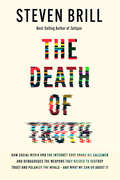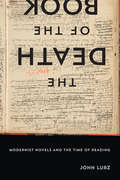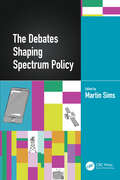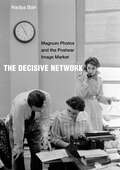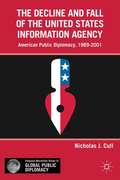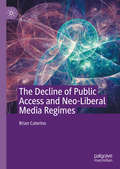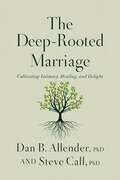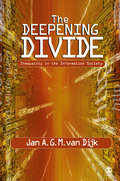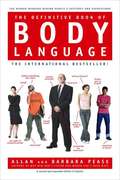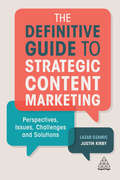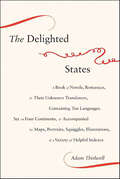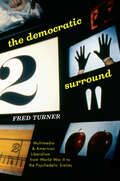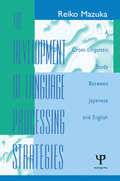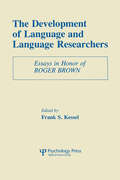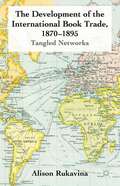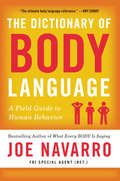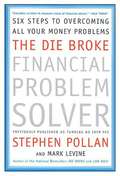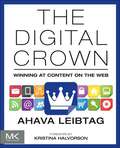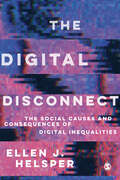- Table View
- List View
The Death of Truth: How Social Media and the Internet Gave Snake Oil Salesmen and Demagogues the Weapons They Needed to Destroy Trust and Polarize the World--And What We Can Do
by Steven BrillHow did we become a world where facts—shared truths—have lost their power to hold us together as a community, as a country, globally? How have we allowed the proliferation of alternative facts, hoaxes, even conspiracy theories, to destroy our trust in institutions, leaders, and legitimate experts? Best-selling journalist Steven Brill documents the forces and people, from Silicon Valley to Madison Avenue to Moscow to Washington, that have created and exploited this world of chaos and division—and offers practical solutions for what we can do about it."A precise description of the punishment cell we have built around our minds and the first few steps back towards light and air." –Timothy Snyder, Author of On Tyranny and Professor of History, Yale University&“A seminal, ground-breaking, documented and honest examination of two of the central dilemmas of our time—what is truth and where to find it.&” —Bob Woodward, associate editor at The Washington PostAs the cofounder of NewsGuard, a company that tracks online misinformation, Steven Brill has observed the rise of fake news from a front-row seat. In The Death of Truth, with startling, often terrifying clarity, he explains how we got here—and how we can get back to a world where truth matters.None of this—conspiracy theories embraced, expertise ridiculed, empirical evidence ignored—has happened by accident. Brill takes us inside the decisions made by executives in Silicon Valley to code the algorithms embedded in their social media platforms to maximize profits by pushing divisive content. He unravels the ingenious creation of automated advertising buying systems that reward that click-baiting content and penalize reliable news publishers, and describes how the use of these ad-financed, misinformation platforms by politicians, hucksters, and conspiracy theorists deceives ordinary citizens. He documents how the most powerful adversaries of America have used American-made social media and advertising tools against us with massive disinformation campaigns—and how, with the development of generative artificial intelligence, everything could get exponentially worse unless we act. The stakes are high for all of us, including Brill himself, whose company's role in exposing Russian disinformation operations resulted in a Russian agent targeting him and his family.Crucially, Brill lays out a series of provocative but realistic prescriptions for what we can do now to reverse course—proposals certain to stir debate and even action that could curb the power of big tech to profit from division and chaos, tamp down polarization, and restore the trust necessary to bring us together.
The Death of the Book: Modernist Novels and the Time of Reading
by John LurzAn examination of the ways major novels by Marcel Proust, James Joyce, and Virginia Woolf draw attention to their embodiment in the object of the book, The Death of the Book considers how bookish format plays a role in some of the twentieth century’s most famous literary experiments. Tracking the passing of time in which reading unfolds, these novels position the book’s so-called death in terms that refer as much to a simple description of its future vis-à-vis other media forms as to the sense of finitude these books share with and transmit to their readers.As he interrogates the affective, physical, and temporal valences of literature’s own traditional format and mode of access, John Lurz shows how these novels stage intersections with the phenomenal world of their readers and develop a conception of literary experience not accounted for by either rigorously historicist or traditionally formalist accounts of the modernist period. Bringing together issues of media and mediation, book history, and modernist aesthetics, The Death of the Book offers a new and deeper understanding of the way we read now.
The Debates Shaping Spectrum Policy
by Martin SimsWhat debates have caused spectrum policy to change course and which will determine its future direction? This book examines these issues through a series of chapters from a range of notable experts. The backdrop is a period of turbulent change in what was once a quiet backwater. The past quarter century has seen wireless connectivity go from nice-to-have luxury to the cornerstone of success as nations battle for leadership of the digital economy. The change has been reflected in the crucial role now played by market's mechanisms in a field once dominated by administrative decisions. Spectrum policy’s goals have moved far beyond the efficient use of the airwaves to include encouraging economic development, investment, innovation, sustainability and digital inclusivity. Are historic procedures still appropriate in the face of this multiplicity of demands? Are market mechanisms like auctions still the best way to deliver what has become essential infrastructure? Does the process of international coordination need to change? Is spectrum policy’s effectiveness limited by the power of global economic forces? Can it reduce rather than add to global warming? Where does 6G and AI fit in? Is public perception the new spectrum policy battle ground? These are all issues examined in The Debates Shaping Spectrum Policy.
The Decisive Network: Magnum Photos and the Postwar Image Market
by Nadya BairSince its founding in 1947, the legendary Magnum Photos agency has been telling its own story about photographers who were witnesses to history and artists on the hunt for decisive moments. Based on unprecedented archival research, The Decisive Network unravels Magnum’s mythologies to offer a new history of what it meant to shoot, edit, and sell news images after World War II. Nadya Bair shows that between the 1940s and 1960s, Magnum expanded the human-interest story to global dimensions while bringing the aesthetic of news pictures into new markets. Working with a vast range of editorial and corporate clients, Magnum made photojournalism integral to postwar visual culture. But its photographers could not have done this alone. By unpacking the collaborative nature of photojournalism, this book shows how picture editors, sales agents, spouses, and publishers helped Magnum photographers succeed in their assignments and achieve fame. Bair concludes in the late 1960s and early 1970s, when changing market conditions led Magnum to consolidate its brand. In that moment, Magnum’s photojournalists became artists and their assignments oeuvres. Bridging art history, media studies, cultural history, and the history of communication, The Decisive Network transforms our understanding of the photographic profession and the global circulation of images in the predigital world.
The Decline and Fall of the United States Information Agency
by Nicholas J. CullUsing newly declassified archives and interviews with practitioners, Nicholas J. Cull has pieced together the story of the final decade in the life of the United States Information Agency, revealing the decisions and actions that brought the United States' apparatus for public diplomacy into disarray.
The Decline of Public Access and Neo-Liberal Media Regimes
by Brian CaterinoThis book examines the reasons behind the declining fortunes of public access channels. Public access, which provided perhaps the boldest experiment in popular media democracy, is in steep decline. While some have argued it is technologically outmoded, Caterino argues that the real reason lies with the rise of a neo-liberal media regime. This regime creates a climate in which we can understand these changes. This book considers the role of neo-liberalism in transforming notions of public obligations and regulation of media that have impacted non-profit media, specifically public access. Neo-liberalism has tried to eliminate public forums and public discourse and weakens institutions of civil society. Though social media is often championed as an arena of communicative freedom, Caterino argues that neo-liberalism has created a colonized social media environment that severely limits popular democracy.
The Deep-Rooted Marriage: Cultivating Intimacy, Healing, and Delight
by Dr. Dan B. Allender Dr. Steve CallWhat if you could experience a marriage that is not just good, but truly life-giving? Therapists Dan Allender and Steve Call show how deeper intimacy can bring more healing and delight.Every relationship has its highs and lows, but we often don't know what to do with our "lows," or how we ended up there. What is creating friction, exacerbating our pain, and standing in the way of intimacy?More often than not, it is the stories of our past drifting into the present. But if we are willing to look at them closely, we will be able to write a new story for the future.With more than seventy years of therapeutic experience combined, Dan Allender and Steve Call demonstrate how God is inviting you and your partner to a wild faith journey with the hope of transformation. With personal stories, key psychological insights, and practical advice, The Deep-Rooted Marriage will help you:Address past trauma, giving you greater courage and compassion to engage your present struggles.Disrupt cycles of conflict based on shame, judgment, and resentment.Create safety when feeling threatened and offer attunement, empathy, and honor toward differences.Adopt humility, honesty, kindness, curiosity, defiance against what divides, and intention to bless.Learn practices that cultivate emotional intimacy, generating new goodness between you and beyond you. Marriage is not about merely getting along or resolving conflict through compromise. It reveals who you are and invites you to who you can become. Marriage offers a space for you to experience what you are made for—honor and delight. And it is the ground from which redemption is meant to grow, where, together, you can reflect God's image more and experience a taste of heaven.
The Deepening Divide: Inequality in the Information Society
by Professor Jan A van DijkThe Deepening Divide: Inequality in the Information Society explains why the digital divide is still widening and, in advanced high-tech societies, deepening. Taken from an international perspective, the book offers full coverage of the literature and research and a theoretical framework from which to analyze and approach the issue. Where most books on the digital divide only describe and analyze the issue, Jan van Dijk presents 26 policy perspectives and instruments designed to close the divide itself.
The Definitive Book of Body Language
by Barbara Pease Allan PeaseAvailable for the first time in the United States, this international bestseller reveals the secrets of nonverbal communication to give you confidence and control in any face-to-face encounter - from making a great first impression and acing a job interview to finding the right partner. It is a scientific fact that people's gestures give away their true intentions. Yet most of us don't know how to read body language and don't realize how our own physical movements speak to others. Now the world's foremost experts on the subject share their techniques for reading body language signals to achieve success in every area of life. Drawing upon more than thirty years in the field, as well as cutting-edge research from evolutionary biology, psychology, and medical technologies that demonstrate what happens in the brain, the authors examine each component of body language and give you the basic vocabulary to read attitudes and emotions through behavior. Discover: How palms and handshakes are used to gain control; The most common gestures of liars; How the legs reveal what the mind wants to do; The most common male and female courtship gestures and signals; The secret signals of cigarettes, glasses, and makeup; The magic of smiles, including smiling advice for women; How to use nonverbal cues and signals to communicate more effectively and get the reactions you want. Filled with fascinating insights, humorous observations, and simple strategies that you can apply to any situation, this intriguing book will enrich your communication with and understanding of others as well as yourself.
The Definitive Book of Body Language: How to read others' attitudes by their gestures
by Barbara Pease Allan PeaseThis international bestseller explains everything you need to know about body language, how to read it, and how to put your best self forwards.What people say is often very different to what they think or feel.Now, with THE DEFINITIVE BOOK OF BODY LANGUAGE, you can learn to read others people's thoughts by their gestures. It sounds implausible, but body language is easy to pick up and fun to use. Find out:How to tell if someone is lyingHow to make yourself likeableHow to get co-operation from other peopleHow to interview and negotiate successfullyHow to choose a partnerLearn the secrets of body language with Allan and Barbara Pease, bestselling authors of WHY MEN DON'T LISTEN AND WOMEN CAN'T READ MAPS.
The Definitive Guide to Strategic Content Marketing: Perspectives, Issues, Challenges and Solutions
by Lazar Dzamic Justin KirbyMarketers everywhere are talking about content, but not everyone is saying the same thing. Some professionals love content and believe it has revolutionized the practice of marketing. To others, it's mere hype: a new name for what marketers have always done. The Definitive Guide to Strategic Content Marketing brings together all of these diverse perspectives, structuring them around useful key topics that provide insight into the multi-faceted nature of content marketing. The editors of The Definitive Guide to Strategic Content Marketing weave different voices together to present a balanced view of content marketing, grouping the discussion around relevant subjects such as content monetization, native advertising, visuals vs video, and the challenge of measuring results. This structure allows readers to move through the book according to their interests, and cherry-pick the most useful aspects of each discussion to apply to their own marketing initiatives. Containing contributions from, and interviews with, leading academics, industry experts, thought leaders and influencers, this book is a truly unique resource.
The Delighted States
by Adam ThirlwellHaving slept with a prostitute in Egypt, a young French novelist named Gustave Flaubert at last abandons sentimentality and begins to write. He influences the obscure French writer Édouard Dujardin, who is read by James Joyce on the train to Trieste, where he will teach English to the Italian novelist Italo Svevo. Back in Paris, Joyce asks Svevo to deliver a suitcase containing notes for Ulysses, a novel that will be viscerated by the expat Gertrude Stein, whose first published story is based on one by Flaubert.This carousel of influence shows how translation and emigration lead to a new and true history of the novel. We devour novels in translation while believing that style does not translate. But the history of the novel is the history of style. The Delighted States attempts to solve this conundrum while mapping an imaginary country, a country of readers: the Delighted States.This book is a provocation, a box of tricks, a bedside travel book; it is also a work of startling intelligence and originality from one of our finest young writers.
The Democratic Surround: Multimedia & American Liberalism from World War II to the Psychedelic Sixties
by Fred TurnerWe commonly think of the psychedelic sixties as an explosion of creative energy and freedom that arose in direct revolt against the social restraint and authoritarian hierarchy of the early Cold War years. Yet, as Fred Turner reveals in The Democratic Surround, the decades that brought us the Korean War and communist witch hunts also witnessed an extraordinary turn toward explicitly democratic, open, and inclusive ideas of communication and with them new, flexible models of social order. Surprisingly, he shows that it was this turn that brought us the revolutionary multimedia and wild-eyed individualism of the 1960s counterculture. In this prequel to his celebrated book From Counterculture to Cyberculture, Turner rewrites the history of postwar America, showing how in the 1940s and '50s American liberalism offered a far more radical social vision than we now remember. Turner tracks the influential mid-century entwining of Bauhaus aesthetics with American social science and psychology. From the Museum of Modern Art in New York to the New Bauhaus in Chicago and Black Mountain College in North Carolina, Turner shows how some of the most well-known artists and intellectuals of the forties developed new models of media, new theories of interpersonal and international collaboration, and new visions of an open, tolerant, and democratic self in direct contrast to the repression and conformity associated with the fascist and communist movements. He then shows how their work shaped some of the most significant media events of the Cold War, including Edward Steichen's Family of Man exhibition, the multimedia performances of John Cage, and, ultimately, the psychedelic Be-Ins of the sixties. Turner demonstrates that by the end of the 1950s this vision of the democratic self and the media built to promote it would actually become part of the mainstream, even shaping American propaganda efforts in Europe. Overturning common misconceptions of these transformational years, The Democratic Surround shows just how much the artistic and social radicalism of the sixties owed to the liberal ideals of Cold War America, a democratic vision that still underlies our hopes for digital media today.
The Development of Language Processing Strategies: A Cross-linguistic Study Between Japanese and English
by Reiko MazukaEver since the notion of explanatory adequacy was promoted by Chomsky in his 1965 Aspects, linguists and psycholinguists have been in pursuit of a psychologically valid theory of grammar. To be explanatorily adequate, a theory of grammar can not only describe the general characteristics of a language but can also account for the underlying psychological processes of acquiring and processing that language. To be considered psychologically valid, a grammar must be learnable by ordinary children (the problem of acquisition) and must generate sentences that are parsable by ordinary people (the problem of processing). Ultimately, the fields of language acquisition and processing are concerned with the same goal: to build a theory that accounts for grammar as it is acquired by children; accessed in comprehension and production of speech; and represented within the human mind. Unfortunately, these two fields developed independently and have rarely been well-informed about each other's concerns. Both have experienced past difficulties as a result. Recently, new models have been developed with full consideration to cross-linguistic diversity. Gone are many of the basic assumptions of conventional models, and in their place a variety of innovative and more flexible assumptions have emerged. However, in their attempt to address cross-linguistic issues, these processing models have yet to fully address the developmental challenge: How can a child without a stable grammar process language and still manage to acquire new grammar? This book attempts to develop a model of language processing that addresses both cross-linguistic and developmental challenges. It proposes to link the setting of a basic configurational parameter during language acquisition to the different organization of processing strategies in left- and right-branching languages. Based primarily on Mazuka's doctoral dissertation, this volume incorporates various responses to the original proposal as well as the author's responses to the comments.
The Development of Language and Language Researchers: Essays in Honor of Roger Brown
by Frank S. KesselFirst published in 1988. This is a collection of essays that were presented at or generated afterwards at a meeting on language acquisition Society Development in April 1981: a symposium on “The Development of Language and Language Researchers: Whatever Happened to Linguistic Theory?” in Boston.
The Development of the International Book Trade, 1870–1895
by By Alison RukavinaAn international trade emerged between 1870-1895 that incorporated the circulation of books among countries worldwide. A history of the social network and select agents who sold and distributed books overseas, this study demonstrates agents increasingly thought of the world as a negotiable, connected system and books as transnational commodities.
The Diary of H. L. Mencken
by Charles A. FecherA Historical Treasure: the never-before, published diary of the most outspoken, iconoclastic, ferociously articulate of American social critics -- the sui generis newspaperman, columnist for the Baltimore Sun, editor of The American Mercury, and author of The American Language, who was admired, feared, and famous for his merciless puncturing of smugness, his genius for deflating pomposity and pretense, his polemical brilliance. Walter Lippmann called him, in 1926, "the most powerful personal influence on this whole generation of educated Americans." H. L. Mencken's diary was, at his own request, kept sealed in the vaults of Baltimore's Enoch Pratt Library for a quarter of a century after his death. The diary covers the years 1930 -- 1948, and provides a vivid, unvarnished, sometimes shocking picture of Mencken himself, his world, and his friends and antagonists, from Theodore Dreiser, F. Scott Fitzgerald, Sinclair Lewis, and William Faulkner to Franklin D. Roosevelt, for whom Mencken nourished a hatred that resulted in spectacular and celebrated feats of invective. From the more than 2,000 pages of typescript that have now come to light, the Mencken scholar Charles A. Fecher has made a generous selection of entries carefully chosen to preserve the whole range, color, and impact of the diary. Here, full scale, is Mencken the unique observer and disturber of American society. And here too is Mencken the human being of wildly contradictory impulses: the skeptic who was prey to small superstitions, the dare-all warrior who was a hopeless hypochondriac, the loving husband and generous friend who was, alas, a bigot. Mencken emerges from these pages unretouched -- in all the often outrageous gadfly vitality that made him, at his brilliant best, so important to the intellectual fabric of American life.
The Dictionary of Body Language: A Field Guide to Human Behavior
by Joe NavarroFrom the world’s #1 body language expert* comes the essential book for decoding human behavior Joe Navarro has spent a lifetime observing others. For 25 years, as a Special Agent for the FBI, he conducted and supervised interrogations of spies and other dangerous criminals, honing his mastery of nonverbal communication. After retiring from the bureau, he has become a sought-after public speaker and consultant, and an internationally bestselling author. Now, a decade after his groundbreaking book What Every BODY is Saying, Navarro returns with his most ambitious work yet. The Dictionary of Body Language is a pioneering “field guide” to nonverbal communication, describing and explaining the more than 400 behaviors that will allow you to gauge anyone’s true intentions.Moving from the head down to the feet, Navarro reveals the hidden meanings behind the many conscious and subconscious things we do. Readers will learn how to tell a person’s actual feelings from subtle changes in their pupils; the lip behaviors that betray concerns or hidden information; the many different varieties of arm posturing, and what each one means; how the position of our thumbs when we stand akimbo reflects our mental state; and many other fascinating insights to help you both read others and change their perceptions of you.Readers will turn to The Dictionary Body Language again and again—a body language bible for anyone looking to understand what their boss really means, interpret whether a potential romantic partner is interested or not, and learn how to put themselves forward in the most favorable light.*GlobalGurus.com
The Die Broke Financial Problem Solver
by Stephen M. Pollan Mark LevineIf you're loosing sleep over your financial worries, help is here at last.Whether you're fretting over a mortgage that's been denied; a loan that's delayed; a marriage settlement that seems unfair; or a business that's struggling, this extraordinary book will not only help you rest easy, it will show you how to turn adversity into success. Here you'll learn the Pollan method for turning no into yes: how to determine your problem; how to make sure you're dealing with only one problem at a time; and how to create an environment of trust. With literally hundreds of scenarios to illustrate it's success, this unique and practical method will make you feel like you've got a coach, strategist, and motivator at your beck and call -- and will help you sleep well, knowing you're on the way to getting what you want.
The Digital Crown: Winning at Content on the Web
by Ahava LeibtagThe Digital Crown walks you through the essentials of crafting great content: the fundamentals of branding, messaging, business goal alignment, and creating portable, mobile content that is future-ready. Systems create freedom, and within this book you’ll learn the seven critical rules to align your internal and external content processes, including putting your audience first, involving stakeholders early and often, and creating multidisciplinary content teams.
The Digital Disconnect: The Social Causes and Consequences of Digital Inequalities
by Ellen HelsperWith the increased digitisation of society comes an increased concern about who is left behind. From societal causes to the impact of everyday actions, The Digital Disconnect explores the relationship between digital and social inequalities, and the lived consequences of digitisation. Ellen Helsper goes beyond questions of digital divides and who is connected. She asks why and how social and digital inequalities are linked and shows the tangible outcomes of socio-digital inequalities in everyday lives. The book: Introduces the key theories and concepts needed to understand both ‘traditional’ and digital inequalities research. Investigates a range of socio-digital inequalities, from digital access and skills, to civic participation, social engagement, and everyday content creation and consumption. Brings research to life with a range of qualitative vignettes, drawing out the personal experiences that lay at the heart of global socio-digital inequalities. The Digital Disconnect is an expert exploration of contemporary theory, research and practice in socio-digital inequalities. It is also an urgent and impassioned call to broaden horizons, expand theoretical and methodological toolkits, and work collectively to help achieve a fairer digital future for all. Ellen J. Helsper is Professor of Digital Inequalities at the Department of Media and Communications at London School of Economics and Political Science.
The Digital Disconnect: The Social Causes and Consequences of Digital Inequalities
by Ellen HelsperWith the increased digitisation of society comes an increased concern about who is left behind. From societal causes to the impact of everyday actions, The Digital Disconnect explores the relationship between digital and social inequalities, and the lived consequences of digitisation. Ellen Helsper goes beyond questions of digital divides and who is connected. She asks why and how social and digital inequalities are linked and shows the tangible outcomes of socio-digital inequalities in everyday lives. The book: Introduces the key theories and concepts needed to understand both ‘traditional’ and digital inequalities research. Investigates a range of socio-digital inequalities, from digital access and skills, to civic participation, social engagement, and everyday content creation and consumption. Brings research to life with a range of qualitative vignettes, drawing out the personal experiences that lay at the heart of global socio-digital inequalities. The Digital Disconnect is an expert exploration of contemporary theory, research and practice in socio-digital inequalities. It is also an urgent and impassioned call to broaden horizons, expand theoretical and methodological toolkits, and work collectively to help achieve a fairer digital future for all. Ellen J. Helsper is Professor of Digital Inequalities at the Department of Media and Communications at London School of Economics and Political Science.
The Digital Dividend of Terrestrial Broadcasting
by Roland BeutlerThe "digital revolution" of the last two decades has pervaded innumerable aspects of our daily lives and changed our planet irreversibly. The shift from analog to digital broadcasting has facilitated a seemingly infinite variety of new applications--audience interactivity being but one example. The greater efficiency and compression of digital media have endowed broadcasters with a "digital dividend" of spare transmission capacity over and above the requirements of terrestrial broadcasting. The question is, who will use it, and how? Comparing the European experience with that of broadcasters elsewhere in the world, the author sketches the current status of international frequency management, quantifies the value of the "dividend" itself, analyzes the details of the analog-to-digital switchovers already completed, and posits what the future holds for the sector. As we grapple with new devices, inconceivable a mere generation ago, that allow us to access digital media instantly, anywhere and at any time of day, this book is a potent reminder that what we have witnessed so far may be just the first wavering steps along a road whose destination we can only guess at.
The Digital Frontier: Infrastructures of Control on the Global Web (Framing the Global)
by Sangeet KumarThe global web and its digital ecosystem can be seen as tools of emancipation, communication, and spreading knowledge or as means of control, fueled by capitalism, surveillance, and geopolitics.The Digital Frontier interrogates the world wide web and the digital ecosystem it has spawned to reveal how their conventions, protocols, standards, and algorithmic regulations represent a novel form of global power. Sangeet Kumar shows the operation of this power through the web's "infrastructures of control" visible at sites where the universalizing imperatives of the web run up against local values, norms, and cultures. These include how the idea of the "global common good" is used as a ruse by digital oligopolies to expand their private enclosures, how seemingly collaborative spaces can simultaneously be exclusionary as they regulate legitimate knowledge, how selfhood is being redefined online along Eurocentric ideals, and how the web's political challenge is felt differentially by sovereign nation states. In analyzing this new modality of cultural power in the global digital ecosystem, The Digital Frontier is an important read for scholars, activists, academics and students inspired by the utopian dream of a truly representative global digital network.
The Digital Glocalization of Entertainment
by Paolo SigismondiIn this volume, Paolo Sigismondi explores the dynamics of global media and entertainment, specifically analyzing the implications of the global rise of non-scripted entertainment (as reality TV programs) and the impact and consequences of the Information and Communication Technology (ICT) revolution on the content, delivery platforms, and overall business models of the media and entertainment landscape. This work aims at bridging the gap between media theories and industry practices in a rapidly evolving global mediascape, building on scholarship in the field and enriched by case studies and insights from business practice. This work demonstrates that the paradigms of the landscape are shifting, introducing the digital "glocalization" of entertainment, through which successful media crossing national and cultural borders incorporate both global and local features. Key questions raised include: Is the ICT revolution an example of disruptive technology for the global media and entertainment industry? Is the existing status quo challenged, and in, particular Hollywood's global leadership? What are the global entities emerging as Hollywood's main competitors in this technologically evolving landscape? Sigismondi argues that as new players are entering the field, new threats to Hollywood's dominance are emerging. The global leaders in non-scripted entertainment, for example, are European-based global entities operating outside the Hollywood system. Meanwhile, the ICT revolution is modifying the contours and boundaries of the global mediascape. Sigismondi's approach provides unique insight into how the forces of technology and globalization are transforming television, cinema, and online entertainment.
